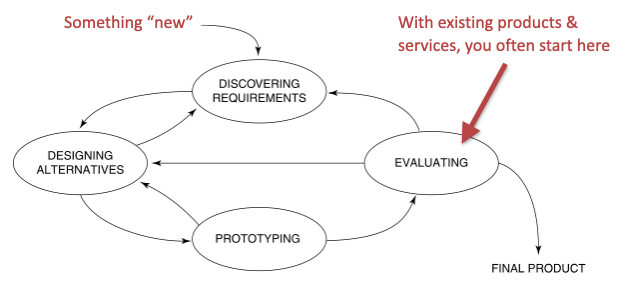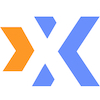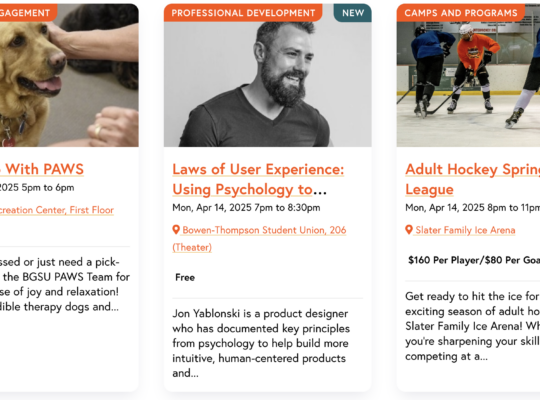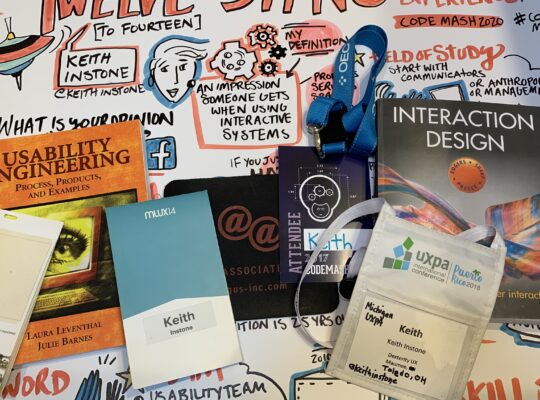It is Spring Break at BGSU, about halfway through the semester. I have “customized” the Usability Engineering class a bit, re-arranging the textbook topics, going deeper in a few areas, and adding a few tidbits from my industry experience.
Order of Topics
I front-loaded chapters that help with the project, where the students are going through the user-centered design process, which will push the psychology topics to the end of the semester.
- Introductions: What is Interaction Design? (Chapter 1), The Process of Interaction Design (2) & Introducing Evaluation (14)
- User Research: Data Gathering (8), Data Analysis (9) & Ethics (10)
- User Interfaces: Interface Types (7) & Prototyping (12)
- Software Engineering: Requirements (11), In Practice/Agile (13)
- Evaluation: Usability Testing (15) & Inspections (16)
- Theory & Science: Chapters 3-6 (Conceptualizing, Cognition, Social, Emotional)
Deeper Materials
Some of the places where I am going beyond the textbook for specific parts of the class.
- Chapter 4 of User Experience Research: User interviews for the user research step of the project
- Chapters 2 & 3 of Designing with the Mind in Mind: UI design principles for a “UI Bloopers” assignment and Q&A with some guest speakers
- A Web for Everyone’s accessibility personas, mapping to different interface types (e.g., augmented reality & accessibility)
- Laws of UX, since Jon Yablonski is visiting class and doing a public talk
- Lots of different resources on persona pros/cons/value, vs. archetypes & scenarios, and using generative AI tools
Reviving Old Stuff
These are things I pulled out of decades-old talks and presentations and updated for the class.
[1] Stressed that “evaluation” can be a “first step” in the process, even though all of the models focus on the “top down” process.

[2] The “user-centered design stuff just wastes time” / anti-quality argument, using the never-said-by-Lincoln quote: A very fast wood cutter was once asked what he would do if he were told he had only five minutes to cut down a tree, or die if he failed. “Well,” said the wood cutter, “I would spend three of the five minutes sharpening my ax.”
[3] Alternatives to User-Centered Design:
- Expert-Centered Design
- Design expert, Subject matter expert
- Technology-Centered Design
- Engineering-Centered Design
- Business-Centered Design
- Profit-Centered Design
[4] Simple Usability Testing Steps
- Have something to test (sketch, prototype, fully-working system)
- Have hypotheses: why test, what do you want to learn?
- Find representative users
- Have them perform representative tasks
- Observe & ask questions: qualitative data
- Survey: more quantitative data
- Summarize what you learned and create next steps that result
[5] Various Ways I’ve Used Usability Testing
- Find the biggest problems that we can actually fix in the next sprint (3-5 users is usually enough): what most people assume usability testing is only good for, and what we are focusing on in the class
- Find every single usability problem (e.g., to fill a backlog)
- Feedback for startups: screen design, flow, content AND business model
- Confirm it is safe to launch a redesign OR NOT (risk management)
- User research & discovery (to complement interviews)
- Competitive analysis (us vs. them) & best practice/pattern confirmation
- Explore brand options (focused more on “feelings” than “performance”)
- Executive & stakeholder awareness/politics (e.g., videos of people struggling to help trigger urgency for change)
- “Scientific research” (statistical significance) to learn general “truths” (or at least to get an academic paper published)
- A combination of several of above (e.g., Lenovo Australia)
Something new that I created was the output (data) from a basic user research project (employees rank task importance) and having the students come up with application architecture recommendations (since most of them want to be software developers). We also spent time critiquing the quality of the user research, hopefully helping them be better consumers of and partners with user research on the job.
I am documenting my journey with the BGSU CS3240 topic.




